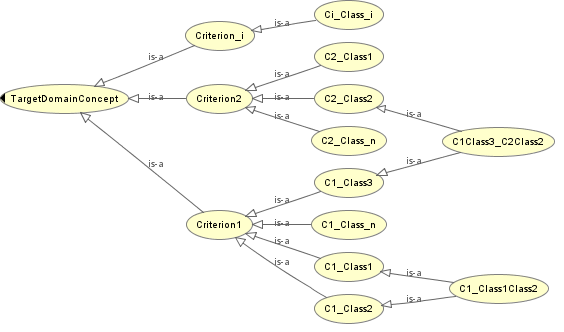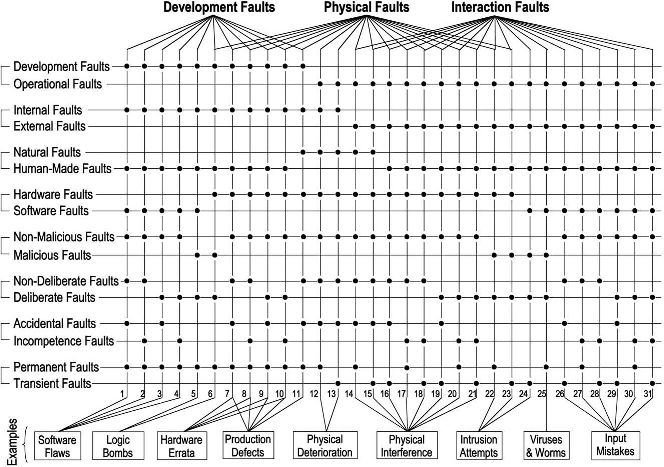Submissions:View Inheritance
From Odp
(Difference between revisions)
| Line 20: | Line 20: | ||
{{Architectural OP Example Template | {{Architectural OP Example Template | ||
|Problem=Matrix representation of Fault in Avizienis et al. [1] used in the ReSIST KB ontology | |Problem=Matrix representation of Fault in Avizienis et al. [1] used in the ReSIST KB ontology | ||
| - | + | {{Include Image |ImageName=Fig_avizienis_fault_5a.jpg}} | |
[1] Avizienis, A., Laprie, J.C., Randell, B., Landwehr, C.: Basic concepts and taxonomy of dependable and secure computing. IEEE Transactions on Dependable and Secure Computing 01(1) (2004) 11--33 | [1] Avizienis, A., Laprie, J.C., Randell, B., Landwehr, C.: Basic concepts and taxonomy of dependable and secure computing. IEEE Transactions on Dependable and Secure Computing 01(1) (2004) 11--33 | ||
| - | + | |Solution=Figure above in particular, shows a matrix representation of all types of faults which may affect a system during its life. Implicitly, the figure reveals several alternative criteria for the classification of faults: | |
| - | | | + | |
| + | * A first criterion can be derived from the left column of the matrix (listing the basic view points from Figure 2: ''Development/Operational Faults'', ''Internal/External Faults'' and so on). This column represents the values of the eight basic viewpoints which lead to the elementary fault classes. | ||
| + | * A second criterion can be abstracted from the bottom row (listing numbers 1 to 31). This row represents the 31 likely combinations of fault classes out of the 256 possible. | ||
| + | * A third criterion is implicit at the top row, representing the three major partially overlapping groupings of faults: ''Development'', ''Physical'' and ''Interaction''. | ||
| + | * A fourth criterion can be seen at the bottom row, labeled ''Examples'', containing nine illustrative examples of fault classes. | ||
| + | }} | ||
| + | {{Architectural OP Reference Template | ||
| + | |RelatedTo=Normalization, Classes As Property Values, Multiple Inheritance | ||
}} | }} | ||
| - | |||
{{Scenarios about me}} | {{Scenarios about me}} | ||
{{Reviews about me}} | {{Reviews about me}} | ||
Revision as of 16:16, 29 August 2009

| If you are a member of quality committee please visit the
If you are author of this proposal or you want to contribute to this pattern's review, you can: specify if this revision takes in account any of the review(s) In general, it could be useful to visit the evaluation section to have information about the evaluation process of this proposal Current revision ID: 5642 |
General information
| Name | View Inheritance |
|---|---|
| Also known as | |
| Author(s) | Benedicto Rodriguez-Castro, Hugh Glaser |
| Domain (if applicable) | |
| Submitted by | BenedictoRodriguezCastro, HughGlaser |
Description
| Problem description | There are ontology domain concepts that are difficult to represent due to the complexities in their definition and the presence of multiple alternative criteria to classify their abstractions. |
|---|---|
| Solution description | Introduce the following types of classes:
|
| Implementation workflow | |
| Reusable component |
Example
| Problem example | Matrix representation of Fault in Avizienis et al. [1] used in the ReSIST KB ontology
[1] Avizienis, A., Laprie, J.C., Randell, B., Landwehr, C.: Basic concepts and taxonomy of dependable and secure computing. IEEE Transactions on Dependable and Secure Computing 01(1) (2004) 11--33 |
|---|---|
| Solution example | Figure above in particular, shows a matrix representation of all types of faults which may affect a system during its life. Implicitly, the figure reveals several alternative criteria for the classification of faults:
|
| Consequences |
Pattern reference
| Origin | |
|---|---|
| Known use | |
| Reference | |
| Related ODP | Normalization, Classes As Property Values, Multiple Inheritance |
Scenarios
Scenarios about View Inheritance
No scenario is added to this Content OP.
Reviews
Reviews about View Inheritance
There is no review about this proposal. This revision (revision ID 5642) takes in account the reviews: none
Other info at evaluation tab



